Consumer Behavior and Decision-Making Process at Marks & Spencer
VerifiedAdded on 2021/02/19
|12
|4132
|31
Report
AI Summary
This report delves into the realm of consumer behavior, examining the decision-making processes that influence purchasing choices, with a specific focus on the retail giant, Marks & Spencer (M&S). The report explores the various stages of consumer decision-making, from need recognition to post-purchase evaluation, and emphasizes the importance of marketers understanding and mapping the consumer's path to purchase. It analyzes how marketers can respond to the decision-making process, applying relevant concepts and models, including cognitive and economic models. Furthermore, the report contrasts and compares the key differences in decision-making processes between B2B and B2C contexts, examining research approaches and factors impacting buying behavior. Finally, it investigates how marketers influence each stage of the decision-making process in both B2B and B2C scenarios, using examples to illustrate these strategies.

CONSUMER INSIGHT
AND BEHAVIOUR
AND BEHAVIOUR
Paraphrase This Document
Need a fresh take? Get an instant paraphrase of this document with our AI Paraphraser
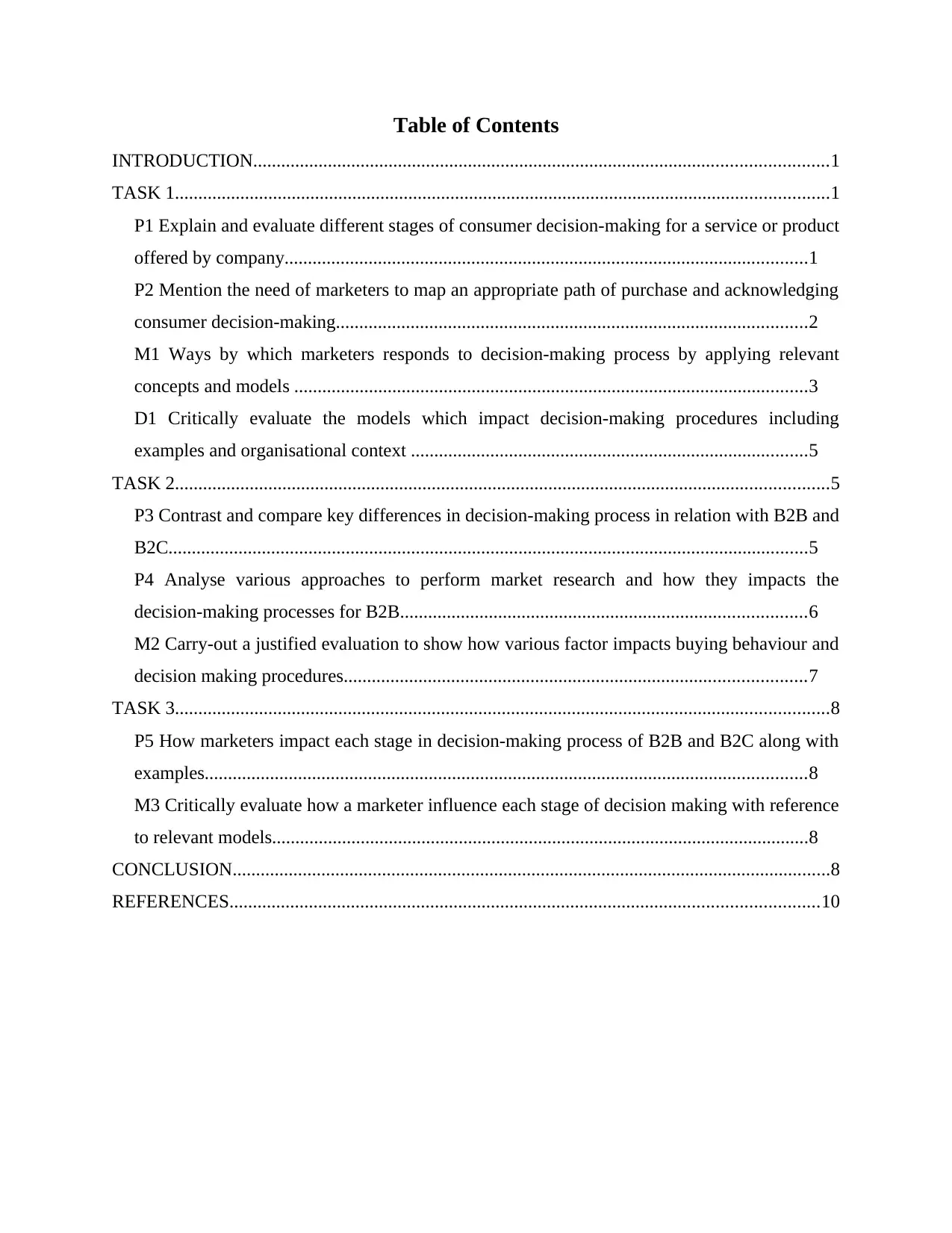
Table of Contents
INTRODUCTION...........................................................................................................................1
TASK 1............................................................................................................................................1
P1 Explain and evaluate different stages of consumer decision-making for a service or product
offered by company................................................................................................................1
P2 Mention the need of marketers to map an appropriate path of purchase and acknowledging
consumer decision-making.....................................................................................................2
M1 Ways by which marketers responds to decision-making process by applying relevant
concepts and models ..............................................................................................................3
D1 Critically evaluate the models which impact decision-making procedures including
examples and organisational context .....................................................................................5
TASK 2............................................................................................................................................5
P3 Contrast and compare key differences in decision-making process in relation with B2B and
B2C.........................................................................................................................................5
P4 Analyse various approaches to perform market research and how they impacts the
decision-making processes for B2B.......................................................................................6
M2 Carry-out a justified evaluation to show how various factor impacts buying behaviour and
decision making procedures...................................................................................................7
TASK 3............................................................................................................................................8
P5 How marketers impact each stage in decision-making process of B2B and B2C along with
examples.................................................................................................................................8
M3 Critically evaluate how a marketer influence each stage of decision making with reference
to relevant models...................................................................................................................8
CONCLUSION................................................................................................................................8
REFERENCES..............................................................................................................................10
INTRODUCTION...........................................................................................................................1
TASK 1............................................................................................................................................1
P1 Explain and evaluate different stages of consumer decision-making for a service or product
offered by company................................................................................................................1
P2 Mention the need of marketers to map an appropriate path of purchase and acknowledging
consumer decision-making.....................................................................................................2
M1 Ways by which marketers responds to decision-making process by applying relevant
concepts and models ..............................................................................................................3
D1 Critically evaluate the models which impact decision-making procedures including
examples and organisational context .....................................................................................5
TASK 2............................................................................................................................................5
P3 Contrast and compare key differences in decision-making process in relation with B2B and
B2C.........................................................................................................................................5
P4 Analyse various approaches to perform market research and how they impacts the
decision-making processes for B2B.......................................................................................6
M2 Carry-out a justified evaluation to show how various factor impacts buying behaviour and
decision making procedures...................................................................................................7
TASK 3............................................................................................................................................8
P5 How marketers impact each stage in decision-making process of B2B and B2C along with
examples.................................................................................................................................8
M3 Critically evaluate how a marketer influence each stage of decision making with reference
to relevant models...................................................................................................................8
CONCLUSION................................................................................................................................8
REFERENCES..............................................................................................................................10
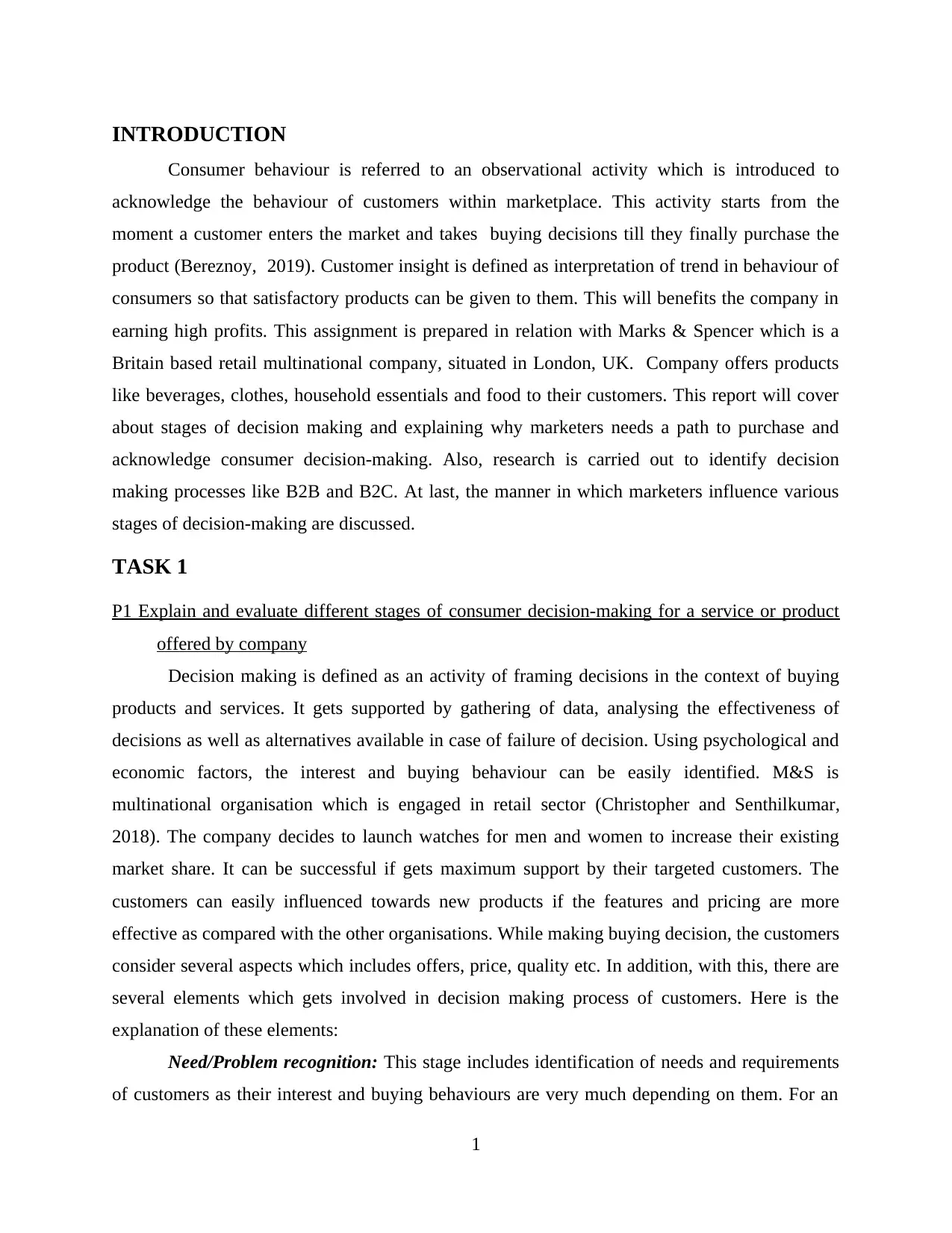
INTRODUCTION
Consumer behaviour is referred to an observational activity which is introduced to
acknowledge the behaviour of customers within marketplace. This activity starts from the
moment a customer enters the market and takes buying decisions till they finally purchase the
product (Bereznoy, 2019). Customer insight is defined as interpretation of trend in behaviour of
consumers so that satisfactory products can be given to them. This will benefits the company in
earning high profits. This assignment is prepared in relation with Marks & Spencer which is a
Britain based retail multinational company, situated in London, UK. Company offers products
like beverages, clothes, household essentials and food to their customers. This report will cover
about stages of decision making and explaining why marketers needs a path to purchase and
acknowledge consumer decision-making. Also, research is carried out to identify decision
making processes like B2B and B2C. At last, the manner in which marketers influence various
stages of decision-making are discussed.
TASK 1
P1 Explain and evaluate different stages of consumer decision-making for a service or product
offered by company
Decision making is defined as an activity of framing decisions in the context of buying
products and services. It gets supported by gathering of data, analysing the effectiveness of
decisions as well as alternatives available in case of failure of decision. Using psychological and
economic factors, the interest and buying behaviour can be easily identified. M&S is
multinational organisation which is engaged in retail sector (Christopher and Senthilkumar,
2018). The company decides to launch watches for men and women to increase their existing
market share. It can be successful if gets maximum support by their targeted customers. The
customers can easily influenced towards new products if the features and pricing are more
effective as compared with the other organisations. While making buying decision, the customers
consider several aspects which includes offers, price, quality etc. In addition, with this, there are
several elements which gets involved in decision making process of customers. Here is the
explanation of these elements:
Need/Problem recognition: This stage includes identification of needs and requirements
of customers as their interest and buying behaviours are very much depending on them. For an
1
Consumer behaviour is referred to an observational activity which is introduced to
acknowledge the behaviour of customers within marketplace. This activity starts from the
moment a customer enters the market and takes buying decisions till they finally purchase the
product (Bereznoy, 2019). Customer insight is defined as interpretation of trend in behaviour of
consumers so that satisfactory products can be given to them. This will benefits the company in
earning high profits. This assignment is prepared in relation with Marks & Spencer which is a
Britain based retail multinational company, situated in London, UK. Company offers products
like beverages, clothes, household essentials and food to their customers. This report will cover
about stages of decision making and explaining why marketers needs a path to purchase and
acknowledge consumer decision-making. Also, research is carried out to identify decision
making processes like B2B and B2C. At last, the manner in which marketers influence various
stages of decision-making are discussed.
TASK 1
P1 Explain and evaluate different stages of consumer decision-making for a service or product
offered by company
Decision making is defined as an activity of framing decisions in the context of buying
products and services. It gets supported by gathering of data, analysing the effectiveness of
decisions as well as alternatives available in case of failure of decision. Using psychological and
economic factors, the interest and buying behaviour can be easily identified. M&S is
multinational organisation which is engaged in retail sector (Christopher and Senthilkumar,
2018). The company decides to launch watches for men and women to increase their existing
market share. It can be successful if gets maximum support by their targeted customers. The
customers can easily influenced towards new products if the features and pricing are more
effective as compared with the other organisations. While making buying decision, the customers
consider several aspects which includes offers, price, quality etc. In addition, with this, there are
several elements which gets involved in decision making process of customers. Here is the
explanation of these elements:
Need/Problem recognition: This stage includes identification of needs and requirements
of customers as their interest and buying behaviours are very much depending on them. For an
1
⊘ This is a preview!⊘
Do you want full access?
Subscribe today to unlock all pages.

Trusted by 1+ million students worldwide
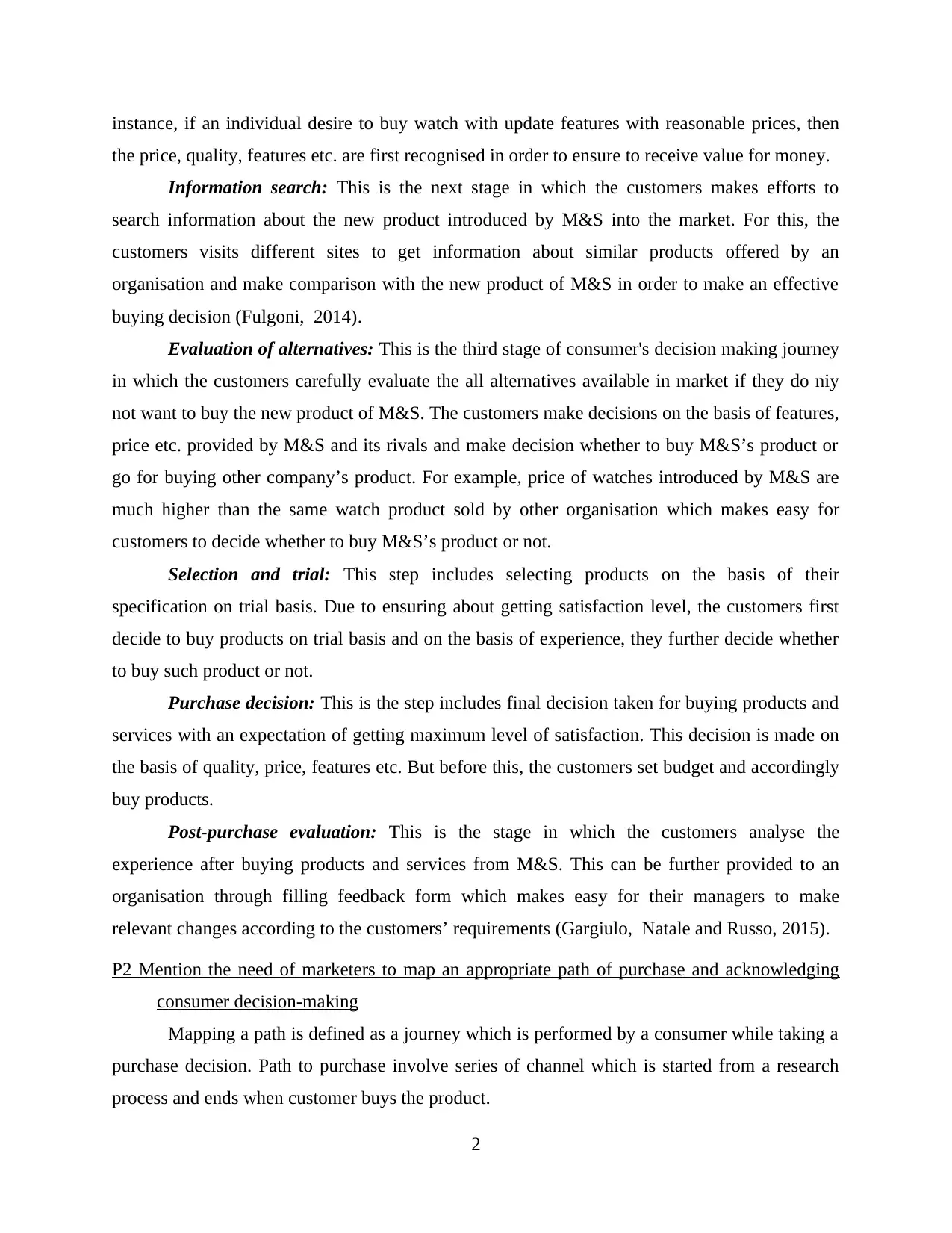
instance, if an individual desire to buy watch with update features with reasonable prices, then
the price, quality, features etc. are first recognised in order to ensure to receive value for money.
Information search: This is the next stage in which the customers makes efforts to
search information about the new product introduced by M&S into the market. For this, the
customers visits different sites to get information about similar products offered by an
organisation and make comparison with the new product of M&S in order to make an effective
buying decision (Fulgoni, 2014).
Evaluation of alternatives: This is the third stage of consumer's decision making journey
in which the customers carefully evaluate the all alternatives available in market if they do niy
not want to buy the new product of M&S. The customers make decisions on the basis of features,
price etc. provided by M&S and its rivals and make decision whether to buy M&S’s product or
go for buying other company’s product. For example, price of watches introduced by M&S are
much higher than the same watch product sold by other organisation which makes easy for
customers to decide whether to buy M&S’s product or not.
Selection and trial: This step includes selecting products on the basis of their
specification on trial basis. Due to ensuring about getting satisfaction level, the customers first
decide to buy products on trial basis and on the basis of experience, they further decide whether
to buy such product or not.
Purchase decision: This is the step includes final decision taken for buying products and
services with an expectation of getting maximum level of satisfaction. This decision is made on
the basis of quality, price, features etc. But before this, the customers set budget and accordingly
buy products.
Post-purchase evaluation: This is the stage in which the customers analyse the
experience after buying products and services from M&S. This can be further provided to an
organisation through filling feedback form which makes easy for their managers to make
relevant changes according to the customers’ requirements (Gargiulo, Natale and Russo, 2015).
P2 Mention the need of marketers to map an appropriate path of purchase and acknowledging
consumer decision-making
Mapping a path is defined as a journey which is performed by a consumer while taking a
purchase decision. Path to purchase involve series of channel which is started from a research
process and ends when customer buys the product.
2
the price, quality, features etc. are first recognised in order to ensure to receive value for money.
Information search: This is the next stage in which the customers makes efforts to
search information about the new product introduced by M&S into the market. For this, the
customers visits different sites to get information about similar products offered by an
organisation and make comparison with the new product of M&S in order to make an effective
buying decision (Fulgoni, 2014).
Evaluation of alternatives: This is the third stage of consumer's decision making journey
in which the customers carefully evaluate the all alternatives available in market if they do niy
not want to buy the new product of M&S. The customers make decisions on the basis of features,
price etc. provided by M&S and its rivals and make decision whether to buy M&S’s product or
go for buying other company’s product. For example, price of watches introduced by M&S are
much higher than the same watch product sold by other organisation which makes easy for
customers to decide whether to buy M&S’s product or not.
Selection and trial: This step includes selecting products on the basis of their
specification on trial basis. Due to ensuring about getting satisfaction level, the customers first
decide to buy products on trial basis and on the basis of experience, they further decide whether
to buy such product or not.
Purchase decision: This is the step includes final decision taken for buying products and
services with an expectation of getting maximum level of satisfaction. This decision is made on
the basis of quality, price, features etc. But before this, the customers set budget and accordingly
buy products.
Post-purchase evaluation: This is the stage in which the customers analyse the
experience after buying products and services from M&S. This can be further provided to an
organisation through filling feedback form which makes easy for their managers to make
relevant changes according to the customers’ requirements (Gargiulo, Natale and Russo, 2015).
P2 Mention the need of marketers to map an appropriate path of purchase and acknowledging
consumer decision-making
Mapping a path is defined as a journey which is performed by a consumer while taking a
purchase decision. Path to purchase involve series of channel which is started from a research
process and ends when customer buys the product.
2
Paraphrase This Document
Need a fresh take? Get an instant paraphrase of this document with our AI Paraphraser
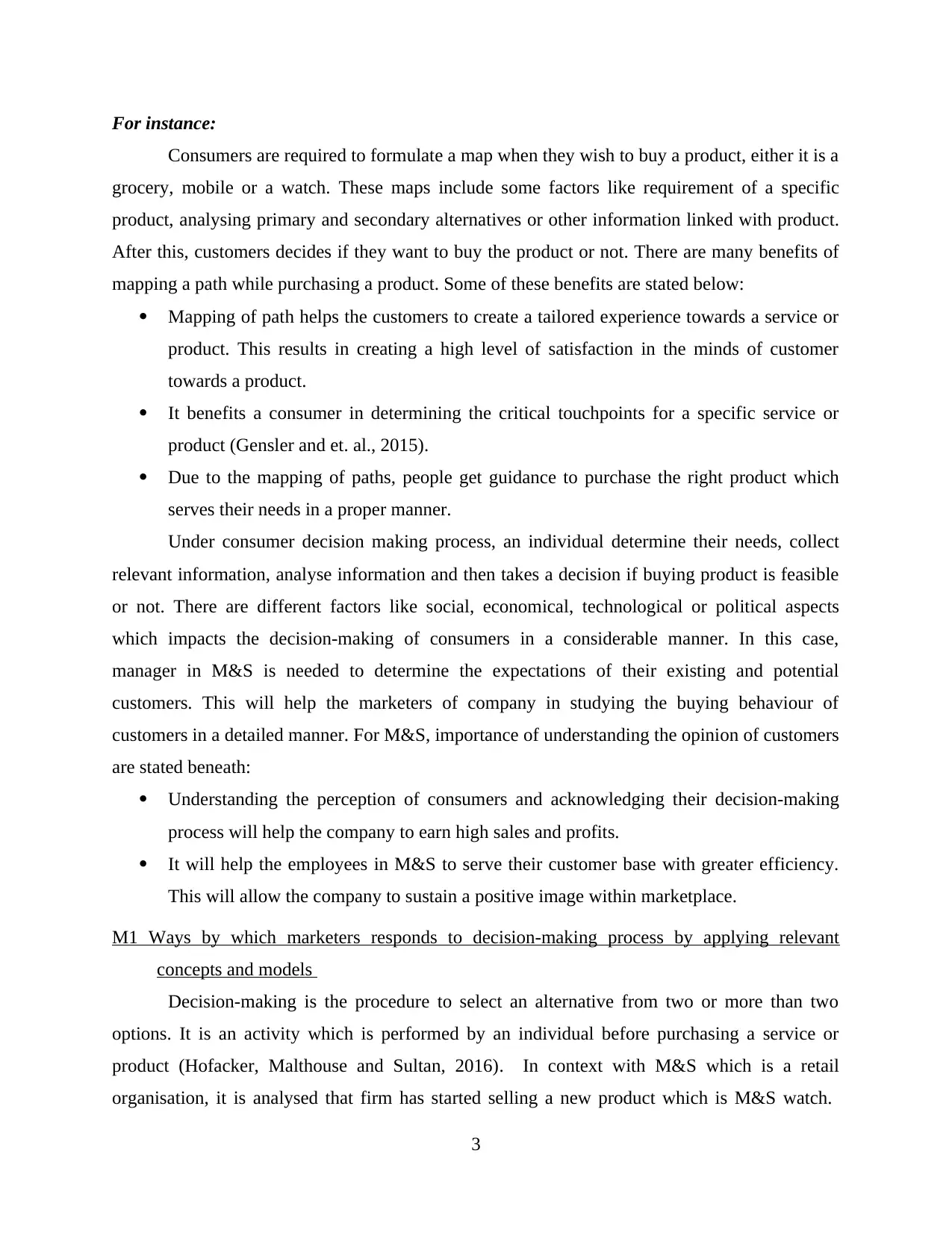
For instance:
Consumers are required to formulate a map when they wish to buy a product, either it is a
grocery, mobile or a watch. These maps include some factors like requirement of a specific
product, analysing primary and secondary alternatives or other information linked with product.
After this, customers decides if they want to buy the product or not. There are many benefits of
mapping a path while purchasing a product. Some of these benefits are stated below:
Mapping of path helps the customers to create a tailored experience towards a service or
product. This results in creating a high level of satisfaction in the minds of customer
towards a product.
It benefits a consumer in determining the critical touchpoints for a specific service or
product (Gensler and et. al., 2015).
Due to the mapping of paths, people get guidance to purchase the right product which
serves their needs in a proper manner.
Under consumer decision making process, an individual determine their needs, collect
relevant information, analyse information and then takes a decision if buying product is feasible
or not. There are different factors like social, economical, technological or political aspects
which impacts the decision-making of consumers in a considerable manner. In this case,
manager in M&S is needed to determine the expectations of their existing and potential
customers. This will help the marketers of company in studying the buying behaviour of
customers in a detailed manner. For M&S, importance of understanding the opinion of customers
are stated beneath:
Understanding the perception of consumers and acknowledging their decision-making
process will help the company to earn high sales and profits.
It will help the employees in M&S to serve their customer base with greater efficiency.
This will allow the company to sustain a positive image within marketplace.
M1 Ways by which marketers responds to decision-making process by applying relevant
concepts and models
Decision-making is the procedure to select an alternative from two or more than two
options. It is an activity which is performed by an individual before purchasing a service or
product (Hofacker, Malthouse and Sultan, 2016). In context with M&S which is a retail
organisation, it is analysed that firm has started selling a new product which is M&S watch.
3
Consumers are required to formulate a map when they wish to buy a product, either it is a
grocery, mobile or a watch. These maps include some factors like requirement of a specific
product, analysing primary and secondary alternatives or other information linked with product.
After this, customers decides if they want to buy the product or not. There are many benefits of
mapping a path while purchasing a product. Some of these benefits are stated below:
Mapping of path helps the customers to create a tailored experience towards a service or
product. This results in creating a high level of satisfaction in the minds of customer
towards a product.
It benefits a consumer in determining the critical touchpoints for a specific service or
product (Gensler and et. al., 2015).
Due to the mapping of paths, people get guidance to purchase the right product which
serves their needs in a proper manner.
Under consumer decision making process, an individual determine their needs, collect
relevant information, analyse information and then takes a decision if buying product is feasible
or not. There are different factors like social, economical, technological or political aspects
which impacts the decision-making of consumers in a considerable manner. In this case,
manager in M&S is needed to determine the expectations of their existing and potential
customers. This will help the marketers of company in studying the buying behaviour of
customers in a detailed manner. For M&S, importance of understanding the opinion of customers
are stated beneath:
Understanding the perception of consumers and acknowledging their decision-making
process will help the company to earn high sales and profits.
It will help the employees in M&S to serve their customer base with greater efficiency.
This will allow the company to sustain a positive image within marketplace.
M1 Ways by which marketers responds to decision-making process by applying relevant
concepts and models
Decision-making is the procedure to select an alternative from two or more than two
options. It is an activity which is performed by an individual before purchasing a service or
product (Hofacker, Malthouse and Sultan, 2016). In context with M&S which is a retail
organisation, it is analysed that firm has started selling a new product which is M&S watch.
3
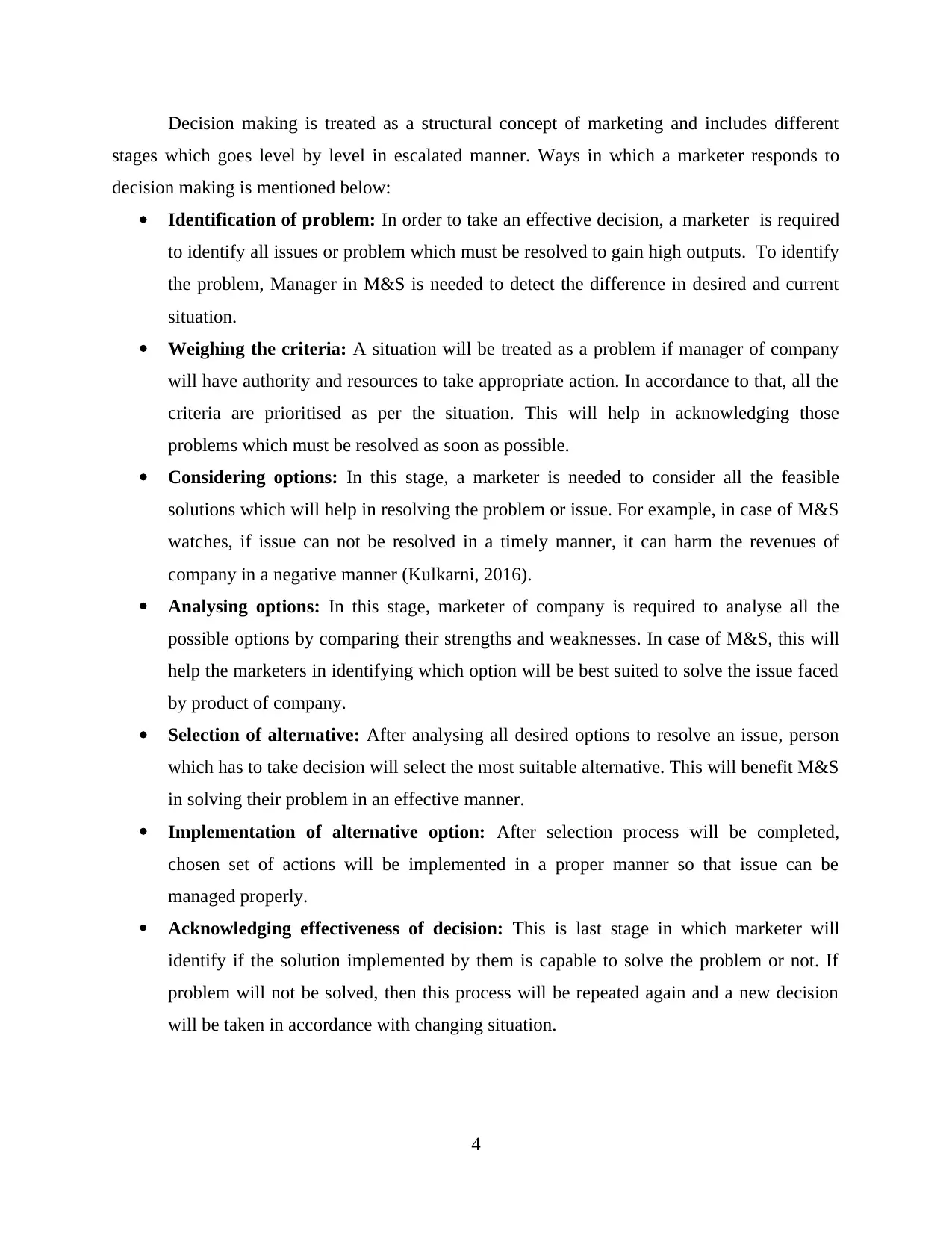
Decision making is treated as a structural concept of marketing and includes different
stages which goes level by level in escalated manner. Ways in which a marketer responds to
decision making is mentioned below:
Identification of problem: In order to take an effective decision, a marketer is required
to identify all issues or problem which must be resolved to gain high outputs. To identify
the problem, Manager in M&S is needed to detect the difference in desired and current
situation.
Weighing the criteria: A situation will be treated as a problem if manager of company
will have authority and resources to take appropriate action. In accordance to that, all the
criteria are prioritised as per the situation. This will help in acknowledging those
problems which must be resolved as soon as possible.
Considering options: In this stage, a marketer is needed to consider all the feasible
solutions which will help in resolving the problem or issue. For example, in case of M&S
watches, if issue can not be resolved in a timely manner, it can harm the revenues of
company in a negative manner (Kulkarni, 2016).
Analysing options: In this stage, marketer of company is required to analyse all the
possible options by comparing their strengths and weaknesses. In case of M&S, this will
help the marketers in identifying which option will be best suited to solve the issue faced
by product of company.
Selection of alternative: After analysing all desired options to resolve an issue, person
which has to take decision will select the most suitable alternative. This will benefit M&S
in solving their problem in an effective manner.
Implementation of alternative option: After selection process will be completed,
chosen set of actions will be implemented in a proper manner so that issue can be
managed properly.
Acknowledging effectiveness of decision: This is last stage in which marketer will
identify if the solution implemented by them is capable to solve the problem or not. If
problem will not be solved, then this process will be repeated again and a new decision
will be taken in accordance with changing situation.
4
stages which goes level by level in escalated manner. Ways in which a marketer responds to
decision making is mentioned below:
Identification of problem: In order to take an effective decision, a marketer is required
to identify all issues or problem which must be resolved to gain high outputs. To identify
the problem, Manager in M&S is needed to detect the difference in desired and current
situation.
Weighing the criteria: A situation will be treated as a problem if manager of company
will have authority and resources to take appropriate action. In accordance to that, all the
criteria are prioritised as per the situation. This will help in acknowledging those
problems which must be resolved as soon as possible.
Considering options: In this stage, a marketer is needed to consider all the feasible
solutions which will help in resolving the problem or issue. For example, in case of M&S
watches, if issue can not be resolved in a timely manner, it can harm the revenues of
company in a negative manner (Kulkarni, 2016).
Analysing options: In this stage, marketer of company is required to analyse all the
possible options by comparing their strengths and weaknesses. In case of M&S, this will
help the marketers in identifying which option will be best suited to solve the issue faced
by product of company.
Selection of alternative: After analysing all desired options to resolve an issue, person
which has to take decision will select the most suitable alternative. This will benefit M&S
in solving their problem in an effective manner.
Implementation of alternative option: After selection process will be completed,
chosen set of actions will be implemented in a proper manner so that issue can be
managed properly.
Acknowledging effectiveness of decision: This is last stage in which marketer will
identify if the solution implemented by them is capable to solve the problem or not. If
problem will not be solved, then this process will be repeated again and a new decision
will be taken in accordance with changing situation.
4
⊘ This is a preview!⊘
Do you want full access?
Subscribe today to unlock all pages.

Trusted by 1+ million students worldwide

D1 Critically evaluate the models which impact decision-making procedures including examples
and organisational context
Decision making of customers is very crucial as it affects the sales and revenue of an
organisation both in positive and negative manner. It can be better explained by overseeing
models developed by scholars and authors which clearly defines the basis on which customers
took buying decisions. Here are such models which clearly explained the consumer decision
making:
Cognitive Model: It is considered as best method which facilitates customers to buy on
the basis of their needs and requirements. This model clearly shows the promotional and
marketing tools used by an organisation makes less impact on decision making of consumers
(Mawoli, 2015). For example, M&S is introducing a new product in market which is M&S
watch. Customers with average or moderate income will only buy it if they will need it. They
will not buy it only because other people are buying it.
Economic Model: It is another model which is not realistic and makes assumption that
human being are more rational while buying products and services. In addition, with this, this
model is also identified that consumer prefer to buy those products which gives them beneficial
outcomes in the context of their satisfaction level. For example, an organisation like M&S offers
wide range of food products and clothings to customers. According to this model, people will
buy them to feel satisfied and show their status. They will not purchase it to satisfy their
requirement. This model is not realistic in nature.
TASK 2
P3 Contrast and compare key differences in decision-making process in relation with B2B and
B2C
The main purpose of commercial organisation is to sell their services or products to the
customers and other organisations so that high revenues can be earned. In B2B sales, products or
services are offered to other businesses whereas in B2C sales, services and products are given to
customers. In this advanced time, each organisation has a aim to gain maximised sales by either
selling it to customers or other companies so that high advantage over rivals can be attained
properly. Difference in B2B and B2C is stated below:
5
and organisational context
Decision making of customers is very crucial as it affects the sales and revenue of an
organisation both in positive and negative manner. It can be better explained by overseeing
models developed by scholars and authors which clearly defines the basis on which customers
took buying decisions. Here are such models which clearly explained the consumer decision
making:
Cognitive Model: It is considered as best method which facilitates customers to buy on
the basis of their needs and requirements. This model clearly shows the promotional and
marketing tools used by an organisation makes less impact on decision making of consumers
(Mawoli, 2015). For example, M&S is introducing a new product in market which is M&S
watch. Customers with average or moderate income will only buy it if they will need it. They
will not buy it only because other people are buying it.
Economic Model: It is another model which is not realistic and makes assumption that
human being are more rational while buying products and services. In addition, with this, this
model is also identified that consumer prefer to buy those products which gives them beneficial
outcomes in the context of their satisfaction level. For example, an organisation like M&S offers
wide range of food products and clothings to customers. According to this model, people will
buy them to feel satisfied and show their status. They will not purchase it to satisfy their
requirement. This model is not realistic in nature.
TASK 2
P3 Contrast and compare key differences in decision-making process in relation with B2B and
B2C
The main purpose of commercial organisation is to sell their services or products to the
customers and other organisations so that high revenues can be earned. In B2B sales, products or
services are offered to other businesses whereas in B2C sales, services and products are given to
customers. In this advanced time, each organisation has a aim to gain maximised sales by either
selling it to customers or other companies so that high advantage over rivals can be attained
properly. Difference in B2B and B2C is stated below:
5
Paraphrase This Document
Need a fresh take? Get an instant paraphrase of this document with our AI Paraphraser
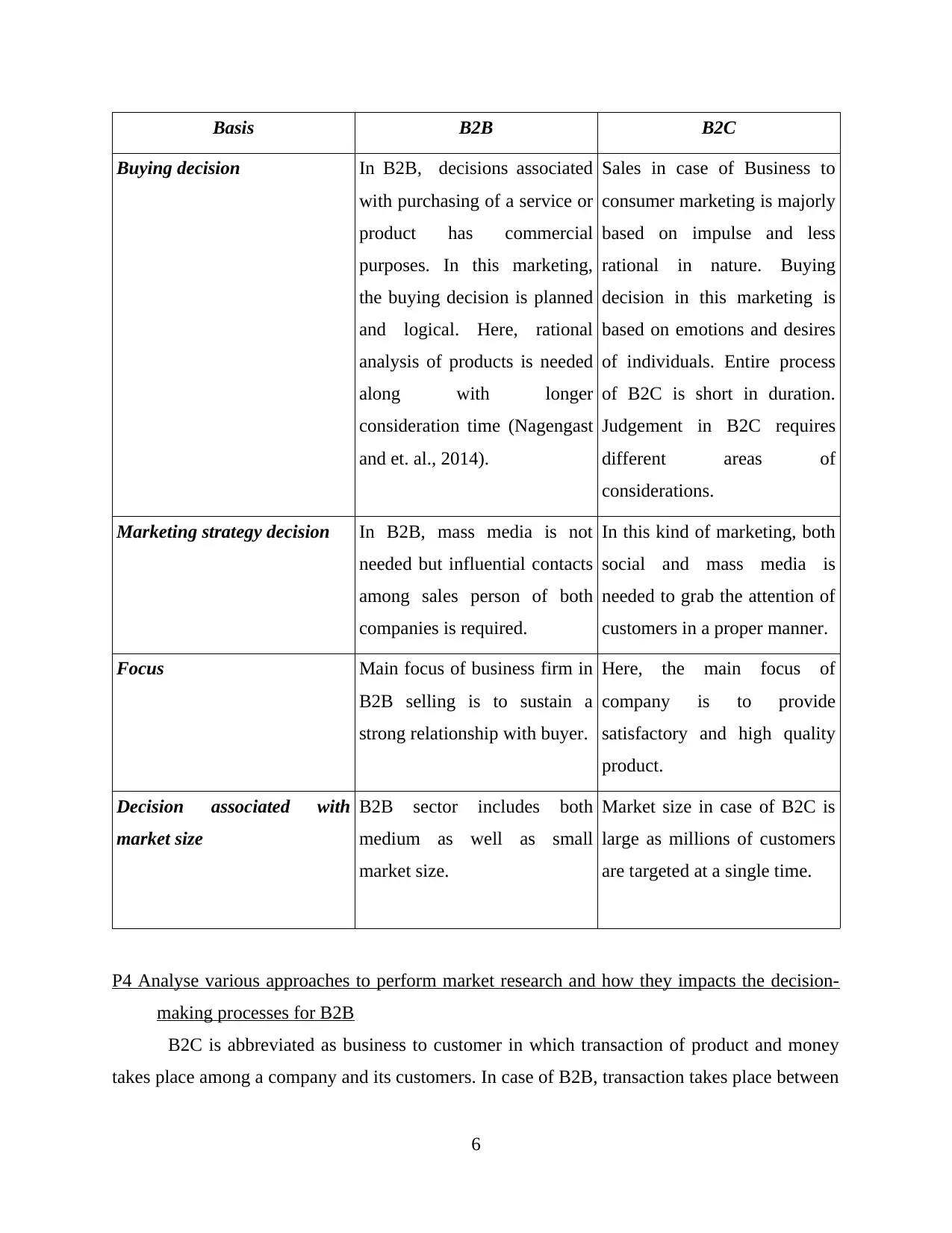
Basis B2B B2C
Buying decision In B2B, decisions associated
with purchasing of a service or
product has commercial
purposes. In this marketing,
the buying decision is planned
and logical. Here, rational
analysis of products is needed
along with longer
consideration time (Nagengast
and et. al., 2014).
Sales in case of Business to
consumer marketing is majorly
based on impulse and less
rational in nature. Buying
decision in this marketing is
based on emotions and desires
of individuals. Entire process
of B2C is short in duration.
Judgement in B2C requires
different areas of
considerations.
Marketing strategy decision In B2B, mass media is not
needed but influential contacts
among sales person of both
companies is required.
In this kind of marketing, both
social and mass media is
needed to grab the attention of
customers in a proper manner.
Focus Main focus of business firm in
B2B selling is to sustain a
strong relationship with buyer.
Here, the main focus of
company is to provide
satisfactory and high quality
product.
Decision associated with
market size
B2B sector includes both
medium as well as small
market size.
Market size in case of B2C is
large as millions of customers
are targeted at a single time.
P4 Analyse various approaches to perform market research and how they impacts the decision-
making processes for B2B
B2C is abbreviated as business to customer in which transaction of product and money
takes place among a company and its customers. In case of B2B, transaction takes place between
6
Buying decision In B2B, decisions associated
with purchasing of a service or
product has commercial
purposes. In this marketing,
the buying decision is planned
and logical. Here, rational
analysis of products is needed
along with longer
consideration time (Nagengast
and et. al., 2014).
Sales in case of Business to
consumer marketing is majorly
based on impulse and less
rational in nature. Buying
decision in this marketing is
based on emotions and desires
of individuals. Entire process
of B2C is short in duration.
Judgement in B2C requires
different areas of
considerations.
Marketing strategy decision In B2B, mass media is not
needed but influential contacts
among sales person of both
companies is required.
In this kind of marketing, both
social and mass media is
needed to grab the attention of
customers in a proper manner.
Focus Main focus of business firm in
B2B selling is to sustain a
strong relationship with buyer.
Here, the main focus of
company is to provide
satisfactory and high quality
product.
Decision associated with
market size
B2B sector includes both
medium as well as small
market size.
Market size in case of B2C is
large as millions of customers
are targeted at a single time.
P4 Analyse various approaches to perform market research and how they impacts the decision-
making processes for B2B
B2C is abbreviated as business to customer in which transaction of product and money
takes place among a company and its customers. In case of B2B, transaction takes place between
6
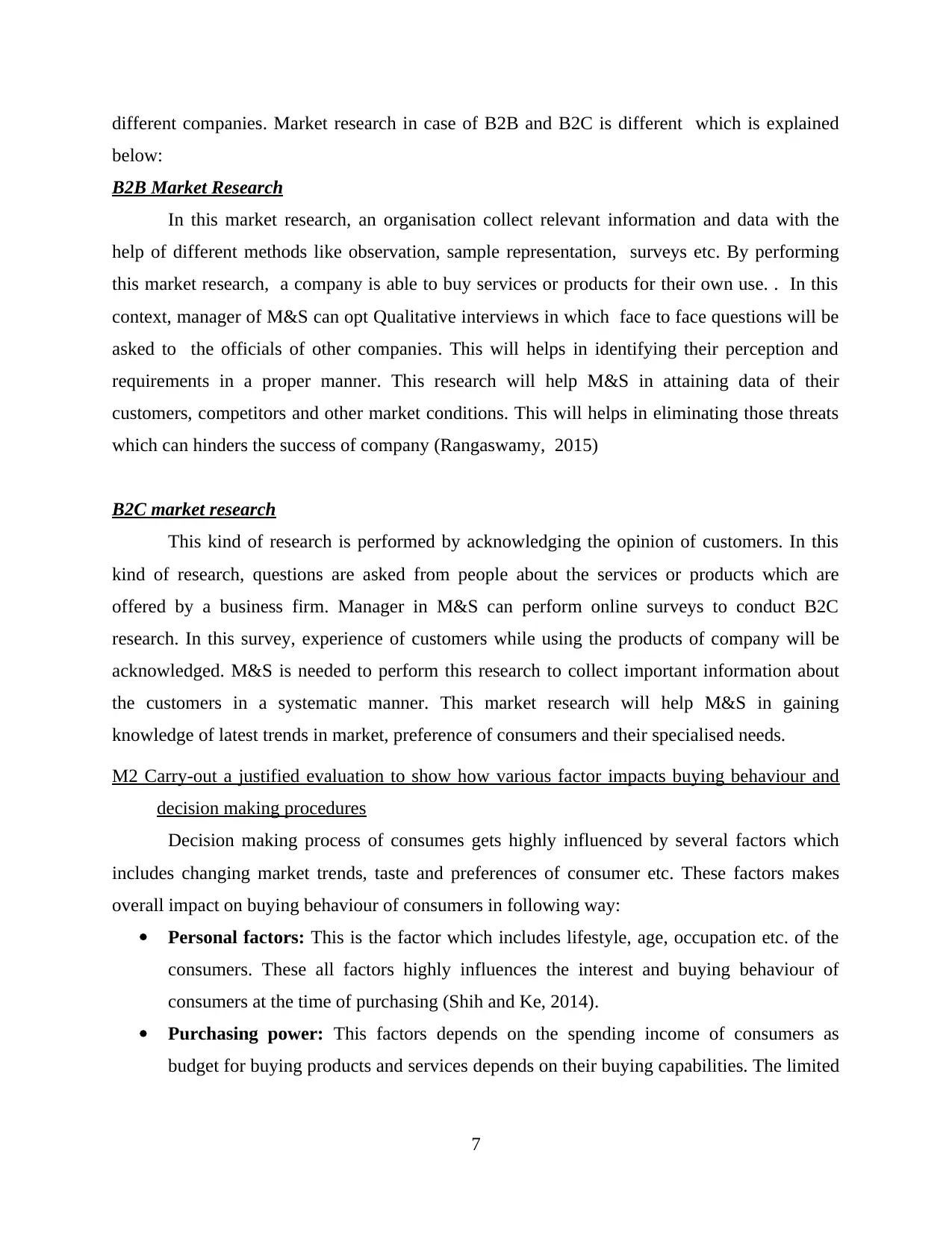
different companies. Market research in case of B2B and B2C is different which is explained
below:
B2B Market Research
In this market research, an organisation collect relevant information and data with the
help of different methods like observation, sample representation, surveys etc. By performing
this market research, a company is able to buy services or products for their own use. . In this
context, manager of M&S can opt Qualitative interviews in which face to face questions will be
asked to the officials of other companies. This will helps in identifying their perception and
requirements in a proper manner. This research will help M&S in attaining data of their
customers, competitors and other market conditions. This will helps in eliminating those threats
which can hinders the success of company (Rangaswamy, 2015)
B2C market research
This kind of research is performed by acknowledging the opinion of customers. In this
kind of research, questions are asked from people about the services or products which are
offered by a business firm. Manager in M&S can perform online surveys to conduct B2C
research. In this survey, experience of customers while using the products of company will be
acknowledged. M&S is needed to perform this research to collect important information about
the customers in a systematic manner. This market research will help M&S in gaining
knowledge of latest trends in market, preference of consumers and their specialised needs.
M2 Carry-out a justified evaluation to show how various factor impacts buying behaviour and
decision making procedures
Decision making process of consumes gets highly influenced by several factors which
includes changing market trends, taste and preferences of consumer etc. These factors makes
overall impact on buying behaviour of consumers in following way:
Personal factors: This is the factor which includes lifestyle, age, occupation etc. of the
consumers. These all factors highly influences the interest and buying behaviour of
consumers at the time of purchasing (Shih and Ke, 2014).
Purchasing power: This factors depends on the spending income of consumers as
budget for buying products and services depends on their buying capabilities. The limited
7
below:
B2B Market Research
In this market research, an organisation collect relevant information and data with the
help of different methods like observation, sample representation, surveys etc. By performing
this market research, a company is able to buy services or products for their own use. . In this
context, manager of M&S can opt Qualitative interviews in which face to face questions will be
asked to the officials of other companies. This will helps in identifying their perception and
requirements in a proper manner. This research will help M&S in attaining data of their
customers, competitors and other market conditions. This will helps in eliminating those threats
which can hinders the success of company (Rangaswamy, 2015)
B2C market research
This kind of research is performed by acknowledging the opinion of customers. In this
kind of research, questions are asked from people about the services or products which are
offered by a business firm. Manager in M&S can perform online surveys to conduct B2C
research. In this survey, experience of customers while using the products of company will be
acknowledged. M&S is needed to perform this research to collect important information about
the customers in a systematic manner. This market research will help M&S in gaining
knowledge of latest trends in market, preference of consumers and their specialised needs.
M2 Carry-out a justified evaluation to show how various factor impacts buying behaviour and
decision making procedures
Decision making process of consumes gets highly influenced by several factors which
includes changing market trends, taste and preferences of consumer etc. These factors makes
overall impact on buying behaviour of consumers in following way:
Personal factors: This is the factor which includes lifestyle, age, occupation etc. of the
consumers. These all factors highly influences the interest and buying behaviour of
consumers at the time of purchasing (Shih and Ke, 2014).
Purchasing power: This factors depends on the spending income of consumers as
budget for buying products and services depends on their buying capabilities. The limited
7
⊘ This is a preview!⊘
Do you want full access?
Subscribe today to unlock all pages.

Trusted by 1+ million students worldwide
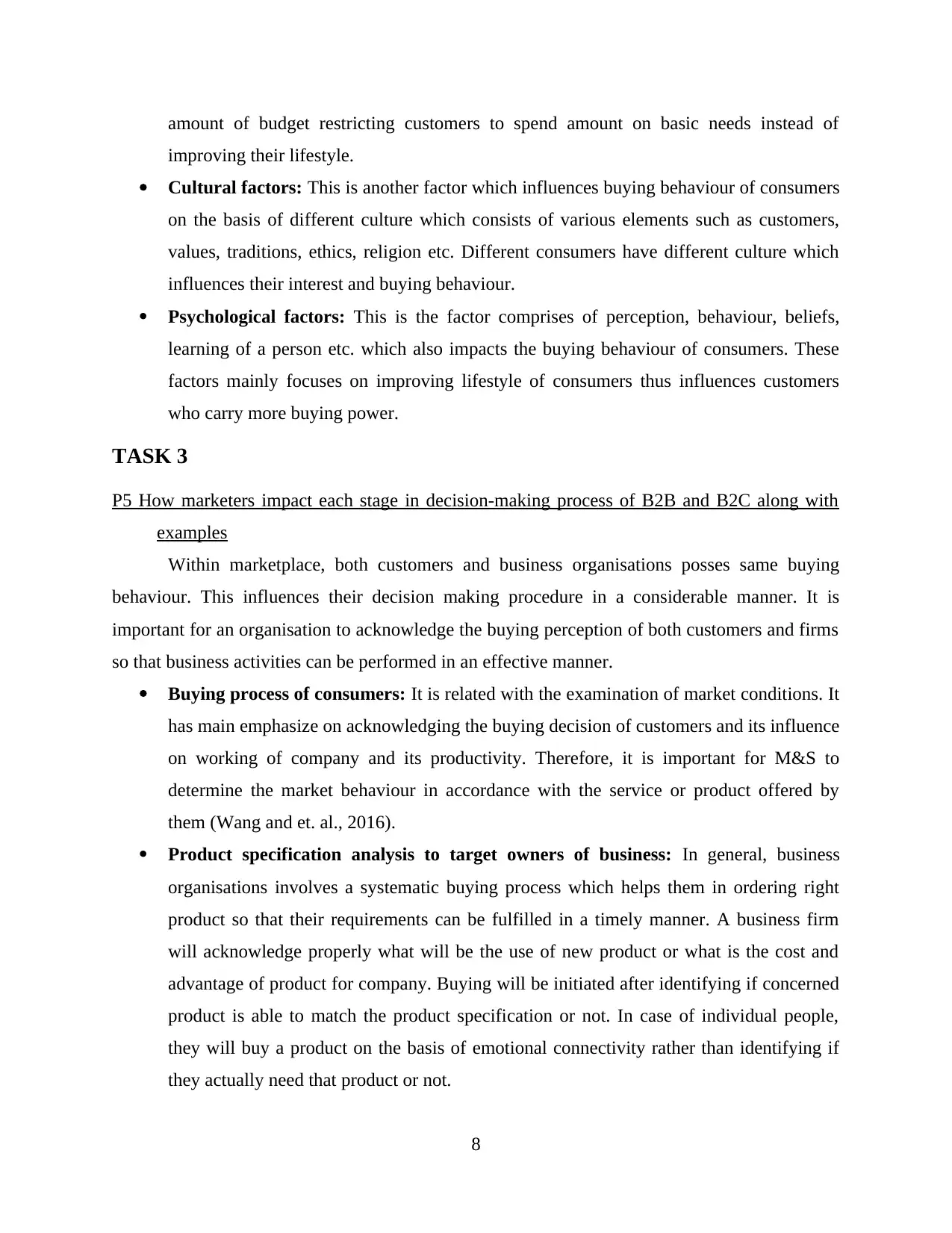
amount of budget restricting customers to spend amount on basic needs instead of
improving their lifestyle.
Cultural factors: This is another factor which influences buying behaviour of consumers
on the basis of different culture which consists of various elements such as customers,
values, traditions, ethics, religion etc. Different consumers have different culture which
influences their interest and buying behaviour.
Psychological factors: This is the factor comprises of perception, behaviour, beliefs,
learning of a person etc. which also impacts the buying behaviour of consumers. These
factors mainly focuses on improving lifestyle of consumers thus influences customers
who carry more buying power.
TASK 3
P5 How marketers impact each stage in decision-making process of B2B and B2C along with
examples
Within marketplace, both customers and business organisations posses same buying
behaviour. This influences their decision making procedure in a considerable manner. It is
important for an organisation to acknowledge the buying perception of both customers and firms
so that business activities can be performed in an effective manner.
Buying process of consumers: It is related with the examination of market conditions. It
has main emphasize on acknowledging the buying decision of customers and its influence
on working of company and its productivity. Therefore, it is important for M&S to
determine the market behaviour in accordance with the service or product offered by
them (Wang and et. al., 2016).
Product specification analysis to target owners of business: In general, business
organisations involves a systematic buying process which helps them in ordering right
product so that their requirements can be fulfilled in a timely manner. A business firm
will acknowledge properly what will be the use of new product or what is the cost and
advantage of product for company. Buying will be initiated after identifying if concerned
product is able to match the product specification or not. In case of individual people,
they will buy a product on the basis of emotional connectivity rather than identifying if
they actually need that product or not.
8
improving their lifestyle.
Cultural factors: This is another factor which influences buying behaviour of consumers
on the basis of different culture which consists of various elements such as customers,
values, traditions, ethics, religion etc. Different consumers have different culture which
influences their interest and buying behaviour.
Psychological factors: This is the factor comprises of perception, behaviour, beliefs,
learning of a person etc. which also impacts the buying behaviour of consumers. These
factors mainly focuses on improving lifestyle of consumers thus influences customers
who carry more buying power.
TASK 3
P5 How marketers impact each stage in decision-making process of B2B and B2C along with
examples
Within marketplace, both customers and business organisations posses same buying
behaviour. This influences their decision making procedure in a considerable manner. It is
important for an organisation to acknowledge the buying perception of both customers and firms
so that business activities can be performed in an effective manner.
Buying process of consumers: It is related with the examination of market conditions. It
has main emphasize on acknowledging the buying decision of customers and its influence
on working of company and its productivity. Therefore, it is important for M&S to
determine the market behaviour in accordance with the service or product offered by
them (Wang and et. al., 2016).
Product specification analysis to target owners of business: In general, business
organisations involves a systematic buying process which helps them in ordering right
product so that their requirements can be fulfilled in a timely manner. A business firm
will acknowledge properly what will be the use of new product or what is the cost and
advantage of product for company. Buying will be initiated after identifying if concerned
product is able to match the product specification or not. In case of individual people,
they will buy a product on the basis of emotional connectivity rather than identifying if
they actually need that product or not.
8
Paraphrase This Document
Need a fresh take? Get an instant paraphrase of this document with our AI Paraphraser
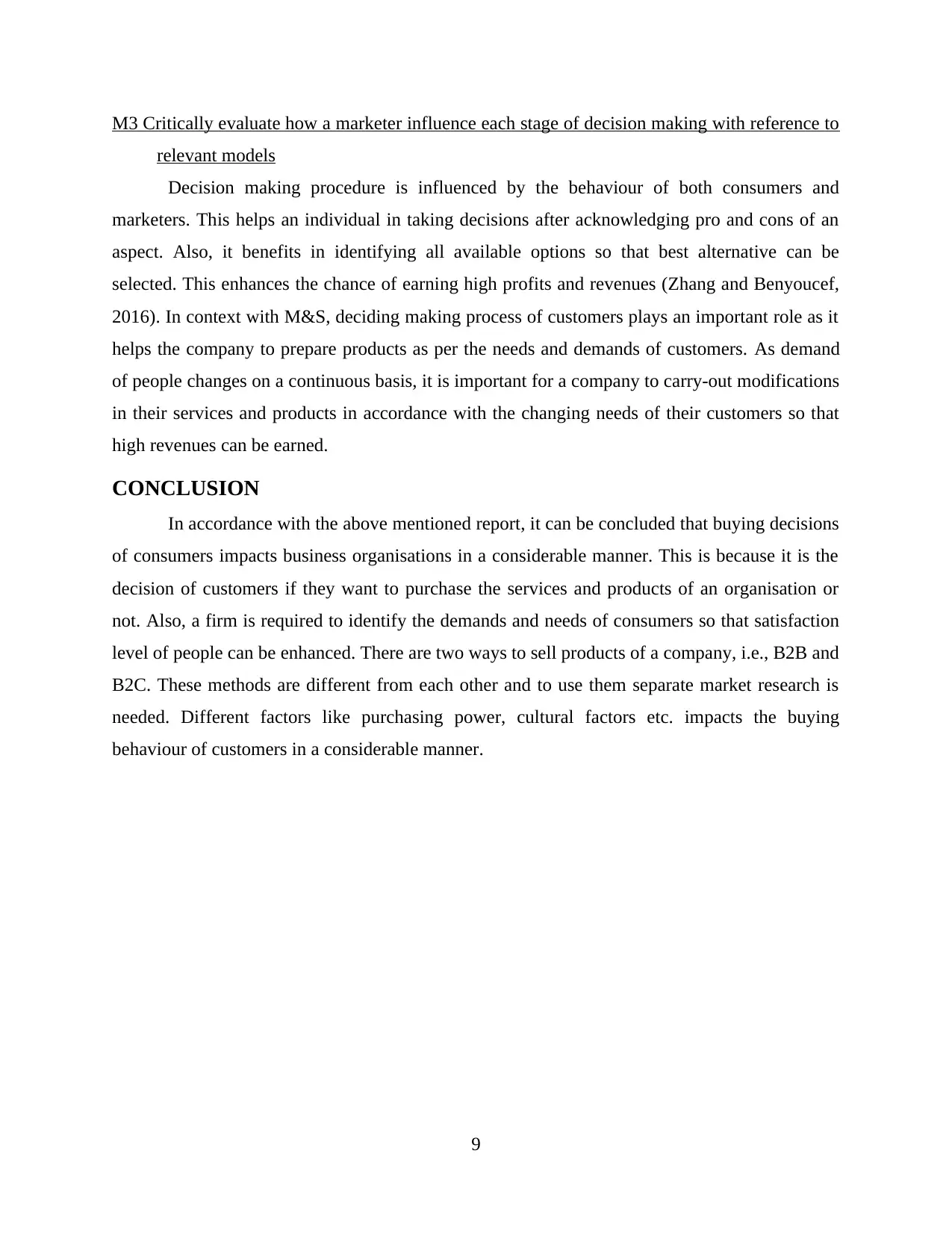
M3 Critically evaluate how a marketer influence each stage of decision making with reference to
relevant models
Decision making procedure is influenced by the behaviour of both consumers and
marketers. This helps an individual in taking decisions after acknowledging pro and cons of an
aspect. Also, it benefits in identifying all available options so that best alternative can be
selected. This enhances the chance of earning high profits and revenues (Zhang and Benyoucef,
2016). In context with M&S, deciding making process of customers plays an important role as it
helps the company to prepare products as per the needs and demands of customers. As demand
of people changes on a continuous basis, it is important for a company to carry-out modifications
in their services and products in accordance with the changing needs of their customers so that
high revenues can be earned.
CONCLUSION
In accordance with the above mentioned report, it can be concluded that buying decisions
of consumers impacts business organisations in a considerable manner. This is because it is the
decision of customers if they want to purchase the services and products of an organisation or
not. Also, a firm is required to identify the demands and needs of consumers so that satisfaction
level of people can be enhanced. There are two ways to sell products of a company, i.e., B2B and
B2C. These methods are different from each other and to use them separate market research is
needed. Different factors like purchasing power, cultural factors etc. impacts the buying
behaviour of customers in a considerable manner.
9
relevant models
Decision making procedure is influenced by the behaviour of both consumers and
marketers. This helps an individual in taking decisions after acknowledging pro and cons of an
aspect. Also, it benefits in identifying all available options so that best alternative can be
selected. This enhances the chance of earning high profits and revenues (Zhang and Benyoucef,
2016). In context with M&S, deciding making process of customers plays an important role as it
helps the company to prepare products as per the needs and demands of customers. As demand
of people changes on a continuous basis, it is important for a company to carry-out modifications
in their services and products in accordance with the changing needs of their customers so that
high revenues can be earned.
CONCLUSION
In accordance with the above mentioned report, it can be concluded that buying decisions
of consumers impacts business organisations in a considerable manner. This is because it is the
decision of customers if they want to purchase the services and products of an organisation or
not. Also, a firm is required to identify the demands and needs of consumers so that satisfaction
level of people can be enhanced. There are two ways to sell products of a company, i.e., B2B and
B2C. These methods are different from each other and to use them separate market research is
needed. Different factors like purchasing power, cultural factors etc. impacts the buying
behaviour of customers in a considerable manner.
9
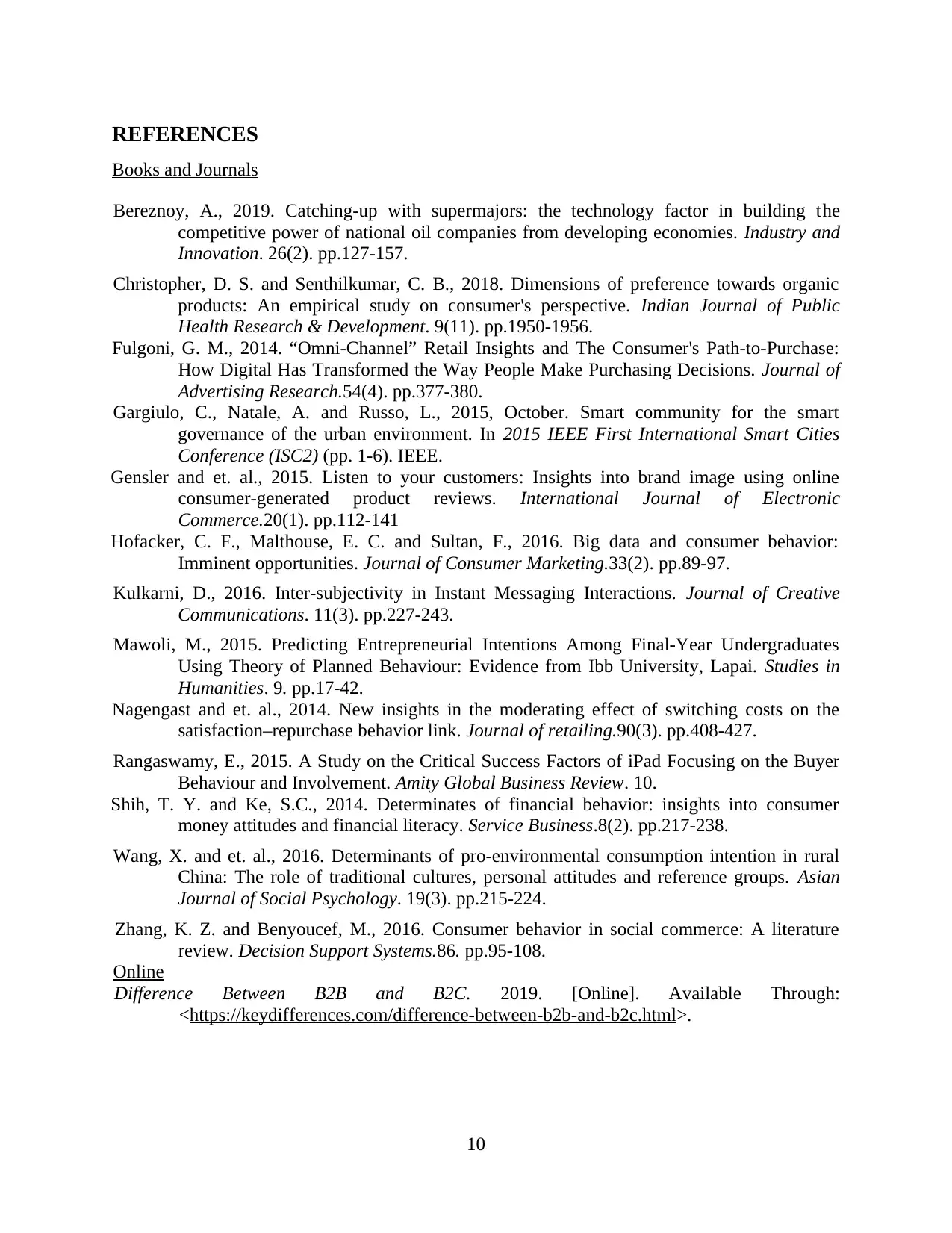
REFERENCES
Books and Journals
Bereznoy, A., 2019. Catching-up with supermajors: the technology factor in building the
competitive power of national oil companies from developing economies. Industry and
Innovation. 26(2). pp.127-157.
Christopher, D. S. and Senthilkumar, C. B., 2018. Dimensions of preference towards organic
products: An empirical study on consumer's perspective. Indian Journal of Public
Health Research & Development. 9(11). pp.1950-1956.
Fulgoni, G. M., 2014. “Omni-Channel” Retail Insights and The Consumer's Path-to-Purchase:
How Digital Has Transformed the Way People Make Purchasing Decisions. Journal of
Advertising Research.54(4). pp.377-380.
Gargiulo, C., Natale, A. and Russo, L., 2015, October. Smart community for the smart
governance of the urban environment. In 2015 IEEE First International Smart Cities
Conference (ISC2) (pp. 1-6). IEEE.
Gensler and et. al., 2015. Listen to your customers: Insights into brand image using online
consumer-generated product reviews. International Journal of Electronic
Commerce.20(1). pp.112-141
Hofacker, C. F., Malthouse, E. C. and Sultan, F., 2016. Big data and consumer behavior:
Imminent opportunities. Journal of Consumer Marketing.33(2). pp.89-97.
Kulkarni, D., 2016. Inter-subjectivity in Instant Messaging Interactions. Journal of Creative
Communications. 11(3). pp.227-243.
Mawoli, M., 2015. Predicting Entrepreneurial Intentions Among Final-Year Undergraduates
Using Theory of Planned Behaviour: Evidence from Ibb University, Lapai. Studies in
Humanities. 9. pp.17-42.
Nagengast and et. al., 2014. New insights in the moderating effect of switching costs on the
satisfaction–repurchase behavior link. Journal of retailing.90(3). pp.408-427.
Rangaswamy, E., 2015. A Study on the Critical Success Factors of iPad Focusing on the Buyer
Behaviour and Involvement. Amity Global Business Review. 10.
Shih, T. Y. and Ke, S.C., 2014. Determinates of financial behavior: insights into consumer
money attitudes and financial literacy. Service Business.8(2). pp.217-238.
Wang, X. and et. al., 2016. Determinants of pro‐environmental consumption intention in rural
China: The role of traditional cultures, personal attitudes and reference groups. Asian
Journal of Social Psychology. 19(3). pp.215-224.
Zhang, K. Z. and Benyoucef, M., 2016. Consumer behavior in social commerce: A literature
review. Decision Support Systems.86. pp.95-108.
Online
Difference Between B2B and B2C. 2019. [Online]. Available Through:
<https://keydifferences.com/difference-between-b2b-and-b2c.html>.
10
Books and Journals
Bereznoy, A., 2019. Catching-up with supermajors: the technology factor in building the
competitive power of national oil companies from developing economies. Industry and
Innovation. 26(2). pp.127-157.
Christopher, D. S. and Senthilkumar, C. B., 2018. Dimensions of preference towards organic
products: An empirical study on consumer's perspective. Indian Journal of Public
Health Research & Development. 9(11). pp.1950-1956.
Fulgoni, G. M., 2014. “Omni-Channel” Retail Insights and The Consumer's Path-to-Purchase:
How Digital Has Transformed the Way People Make Purchasing Decisions. Journal of
Advertising Research.54(4). pp.377-380.
Gargiulo, C., Natale, A. and Russo, L., 2015, October. Smart community for the smart
governance of the urban environment. In 2015 IEEE First International Smart Cities
Conference (ISC2) (pp. 1-6). IEEE.
Gensler and et. al., 2015. Listen to your customers: Insights into brand image using online
consumer-generated product reviews. International Journal of Electronic
Commerce.20(1). pp.112-141
Hofacker, C. F., Malthouse, E. C. and Sultan, F., 2016. Big data and consumer behavior:
Imminent opportunities. Journal of Consumer Marketing.33(2). pp.89-97.
Kulkarni, D., 2016. Inter-subjectivity in Instant Messaging Interactions. Journal of Creative
Communications. 11(3). pp.227-243.
Mawoli, M., 2015. Predicting Entrepreneurial Intentions Among Final-Year Undergraduates
Using Theory of Planned Behaviour: Evidence from Ibb University, Lapai. Studies in
Humanities. 9. pp.17-42.
Nagengast and et. al., 2014. New insights in the moderating effect of switching costs on the
satisfaction–repurchase behavior link. Journal of retailing.90(3). pp.408-427.
Rangaswamy, E., 2015. A Study on the Critical Success Factors of iPad Focusing on the Buyer
Behaviour and Involvement. Amity Global Business Review. 10.
Shih, T. Y. and Ke, S.C., 2014. Determinates of financial behavior: insights into consumer
money attitudes and financial literacy. Service Business.8(2). pp.217-238.
Wang, X. and et. al., 2016. Determinants of pro‐environmental consumption intention in rural
China: The role of traditional cultures, personal attitudes and reference groups. Asian
Journal of Social Psychology. 19(3). pp.215-224.
Zhang, K. Z. and Benyoucef, M., 2016. Consumer behavior in social commerce: A literature
review. Decision Support Systems.86. pp.95-108.
Online
Difference Between B2B and B2C. 2019. [Online]. Available Through:
<https://keydifferences.com/difference-between-b2b-and-b2c.html>.
10
⊘ This is a preview!⊘
Do you want full access?
Subscribe today to unlock all pages.

Trusted by 1+ million students worldwide
1 out of 12
Related Documents
Your All-in-One AI-Powered Toolkit for Academic Success.
+13062052269
info@desklib.com
Available 24*7 on WhatsApp / Email
![[object Object]](/_next/static/media/star-bottom.7253800d.svg)
Unlock your academic potential
Copyright © 2020–2025 A2Z Services. All Rights Reserved. Developed and managed by ZUCOL.




